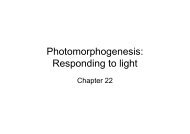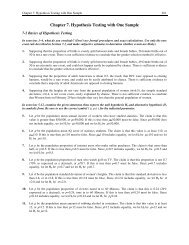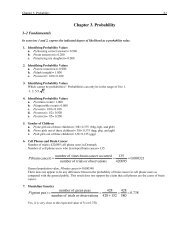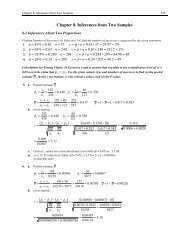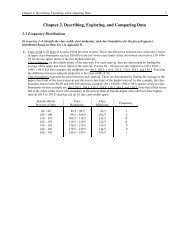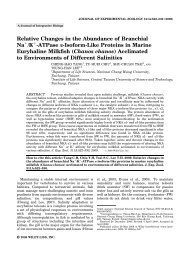Targeting cyclin B1 inhibits proliferation and sensitizes breast ...
Targeting cyclin B1 inhibits proliferation and sensitizes breast ...
Targeting cyclin B1 inhibits proliferation and sensitizes breast ...
Create successful ePaper yourself
Turn your PDF publications into a flip-book with our unique Google optimized e-Paper software.
9ResultsCancer cell lines lend themselves as useful models to further our underst<strong>and</strong>ing ofgynecological cancers such as <strong>breast</strong> <strong>and</strong> cervical cancer. To study the function of <strong>cyclin</strong> <strong>B1</strong>in <strong>breast</strong> cancer cells we selected cancer cell lines MCF-7, BT-474, SK-BR-3 <strong>and</strong> MDA-MB-231, as they represent the best characterized cell lines for <strong>breast</strong> cancer research. While MCF-7 <strong>and</strong> BT-474 express both estrogen receptor (ER) <strong>and</strong> progesterone receptor (PgR), SK-BR-3<strong>and</strong> MDA-MB-231 cells lack those receptors [30]. Unlike SK-BR-3 <strong>and</strong> BT-474, which areHer-2/neu-positive, MCF-7 cells only exhibit a basal level of Her-2/neu [30]. In addition,MCF-7 cells express high amounts of markers typical of the luminal epithelia phenotype of<strong>breast</strong> cells, whereas BT-474 <strong>and</strong> SK-BR-3 cells exhibit a weakly luminal epithelia-likephenotype. Distinct from the two phenotypes above, MDA-MB-231 represents a highlyinvasive “mesenchymal-like“ <strong>breast</strong> cancer cell line by expressing a high level of vimentin.In addition, the cervical cancer cell line HeLa was selected, because it represents the mostextensively studied cancer cell line thus far.Specific downregulation of <strong>cyclin</strong> <strong>B1</strong> with siRNAWe were at first interested whether <strong>breast</strong> cancer cell lines are similarly sensitive to specificdownregulation of <strong>cyclin</strong> <strong>B1</strong> by siRNA. As shown in Fig. 1A, while the protein level of<strong>cyclin</strong> <strong>B1</strong> in MDA-MB-231 was almost undetectable after treatment with siRNA1 or siRNA3,33% <strong>and</strong> 16% of <strong>cyclin</strong> <strong>B1</strong> were still detectable in MCF-7 cells after treatment with siRNA1<strong>and</strong> siRNA3, respectively, relative to the protein level of <strong>cyclin</strong> <strong>B1</strong> in control cells. In contrastto <strong>cyclin</strong> <strong>B1</strong>, β-actin was not affected. The protein level of Cdk1, the catalytic partner of<strong>cyclin</strong> <strong>B1</strong>, hardly changed, indicating <strong>cyclin</strong> <strong>B1</strong> knockdown by siRNAs was specific.Treatment of BT-474 <strong>and</strong> SK-BR-3 cells with siRNA1 <strong>and</strong> siRNA3 also reduced <strong>cyclin</strong> <strong>B1</strong>levels, albeit to a lower extent as compared to MDA-MB-231 <strong>and</strong> MCF-7 cells.10staining with monoclonal specific antibodies against <strong>cyclin</strong> <strong>B1</strong> (data not shown). Furthermore,in consistence with downregulation of <strong>cyclin</strong> <strong>B1</strong> protein, the kinase activity of Cdk1/<strong>cyclin</strong><strong>B1</strong> was decreased to 28% in cellular extracts from siRNA1-treated BT-474 cells as comparedto siGFP-treated cells (Fig. 1B). Similar results were also obtained in MCF-7 cells aftersiRNA administration (data not shown).Proliferation is inhibited in <strong>breast</strong> cancer cells with reduced <strong>cyclin</strong> <strong>B1</strong>As Cdk1/<strong>cyclin</strong> <strong>B1</strong> is essential for the initiation of mitosis <strong>and</strong> required for cell division wesubsequently studied the impact of <strong>cyclin</strong> <strong>B1</strong> downregulation on cell <strong>proliferation</strong> rate.Expectedly, a reduced <strong>proliferation</strong> was observed in all four <strong>breast</strong> cancer cell lines after 48 htreatment with siRNAs as compared to control cells treated with siGFP (Fig. 2). In particular,MCF-7 cells exhibited a strong inhibition of <strong>proliferation</strong>, followed by MDA-MB-231, BT-474 <strong>and</strong> SK-BR-3 cells after 48 h siRNA1-3 treatment against <strong>cyclin</strong> <strong>B1</strong> (Fig. 2A-D, upperpanels). Analyses of cell cycle distribution displayed an accumulation of cells in G2/M phase,suggestive of a G2/M arrest, after treatment with siRNA1-3 targeting <strong>cyclin</strong> <strong>B1</strong> (Fig. 2A-D,lower panels).Time kinetics of siRNA treatment in MCF-7 cellsIn order to study the effect of cycin <strong>B1</strong> knockdown on <strong>proliferation</strong>, we subjected MCF-7cells to more detailed time dependent analysis. MCF-7 cells were treated with siRNA1 orsiRNA3 <strong>and</strong> harvested for Western blot analysis <strong>and</strong> <strong>proliferation</strong> assay at the indicated timepoints. The reduction of <strong>cyclin</strong> <strong>B1</strong> protein levels were evident 24 h after siRNA1/3 treatmentas compared to control cells (Fig. 3A). This effect increased dramatically with time <strong>and</strong> after96 h <strong>cyclin</strong> <strong>B1</strong> protein became undetectable. In line with the reduction of <strong>cyclin</strong> <strong>B1</strong>, theDownregulation of <strong>cyclin</strong> <strong>B1</strong> was also corroborated by indirect immunofluorenscence<strong>proliferation</strong> rate of MCF-7 cells was clearly inhibited at 24 h with siRNA3 treatment <strong>and</strong> theinhibition became more striking with longer exposure to siRNA1 (Fig. 3B).11investigated the combination of knockdown of <strong>cyclin</strong> <strong>B1</strong> with irradiation. Irradiationenhanced the G2/M population <strong>and</strong> induced more apoptosis in <strong>cyclin</strong> <strong>B1</strong> reduced MCF-712cells, compared to control cells (data not shown).Suppression of <strong>cyclin</strong> <strong>B1</strong> renders cells more susceptible to taxolTaxol (Paclitaxel ® ), a taxane frequently used in multidrug regiments for the therapy of severalImpaired colony-forming ability <strong>and</strong> inhibited tumor growthsolid tumors, binds to the β-subunit of tubulin,thereby impairing the dynamics ofAnchorage independent cell growth is one of the hallmarks of malignant tumor cells. Givenmicrotubules by promoting their polymerization, leading to mitotic arrest <strong>and</strong> apoptosis [31].In order to explore <strong>cyclin</strong> <strong>B1</strong> knockdown as a possible combination with taxol, we transfectedMCF-7 cells with siRNA3 <strong>and</strong> followed by further incubation with taxol. Cells wereharvested 48 h posttransfection. As depicted in Fig. 4A, <strong>cyclin</strong> <strong>B1</strong> protein level was stronglyreduced after siRNA3 treatment. Cyclin <strong>B1</strong> level was also decreased after treatment withtaxol at a low dosage of 3 ng/ml, possibly due to the induction of apoptosis, <strong>and</strong> almostdisappeared when cells were pre-treated with siRNA3 (Fig. 4A, upper panel). Indeed, PARP(poly(ADP-ribose) polymerase) was cleaved in cells treated with taxol <strong>and</strong> more stronglycleaved when siRNA3 was used together with taxol (Fig. 4A, middle panel), indicating thatthe combined treatment triggers more robust apoptotic response. In addition, <strong>proliferation</strong> wasinhibited to a higher extent after the combined treatment (Fig. 4B). The results were furthercorrelated with the cell cycle analysis: a G2/M population was more prominent in MCF-7cells after the combined treatment, compared to cells exposed to siRNA3 alone (Fig. 4C). Thedata indicate that the combined therapy activates more strongly caspase-3 independentapoptotic pathways in MCF-7 cells as the caspase-3 gene is deleted in MCF-7 cells [32].the notion of <strong>cyclin</strong> <strong>B1</strong> deregulation being involved in neoplastic transformation <strong>and</strong>associated with malignancy grade of tumors, we wondered whether knockdown of <strong>cyclin</strong> <strong>B1</strong>protein might translate into reduced colony-forming ability in MCF-7 cells. As shown in Fig.5A, the colony numbers of MCF-7 cells treated with siRNA1-3 were strongly reduced, inparticular, in MCF-7 cells treated with siRNA3, compared to controls.Cervical carcinoma HeLa cells express a high level of <strong>cyclin</strong> <strong>B1</strong> (data not shown). In cellculture, only 25-30% HeLa cells were left after 48 h treatment with siRNA3 targeting <strong>cyclin</strong><strong>B1</strong> (data not shown). To further address whether <strong>cyclin</strong> <strong>B1</strong> is required for aggressive growthof tumors in vivo, a xenograft experiment with HeLa cells was performed in nude mice. Micewere inoculated with HeLa cells treated 48 h with siRNA3 targeting <strong>cyclin</strong> <strong>B1</strong> or siGFP. Asshown in Fig. 5B, tumor growth of HeLa cells treated with siRNA3 prior to inoculation waseffectually retarded, in comparison with the growth of control HeLa tumors. The data suggestthat <strong>cyclin</strong> <strong>B1</strong> is indeed required in vivo for promoting <strong>proliferation</strong> of tumor cells <strong>and</strong> thereduction of <strong>cyclin</strong> <strong>B1</strong> slows down the tumor growth.Similar results were also obtained in MDA-MB-231 cells: while siRNA3 or taxol alonereduced <strong>proliferation</strong> by 33% <strong>and</strong> 31%, respectively, relative to siGFP treatment, thecombination of siRNA3 with taxol resulted in a 65% reduction of <strong>proliferation</strong> (data notshown). Thus, the combined action of <strong>cyclin</strong> <strong>B1</strong> knockdown together with taxol enhancesantiproliferative <strong>and</strong>proapoptotic responses in <strong>breast</strong> cancer cells. Furthermore, we



